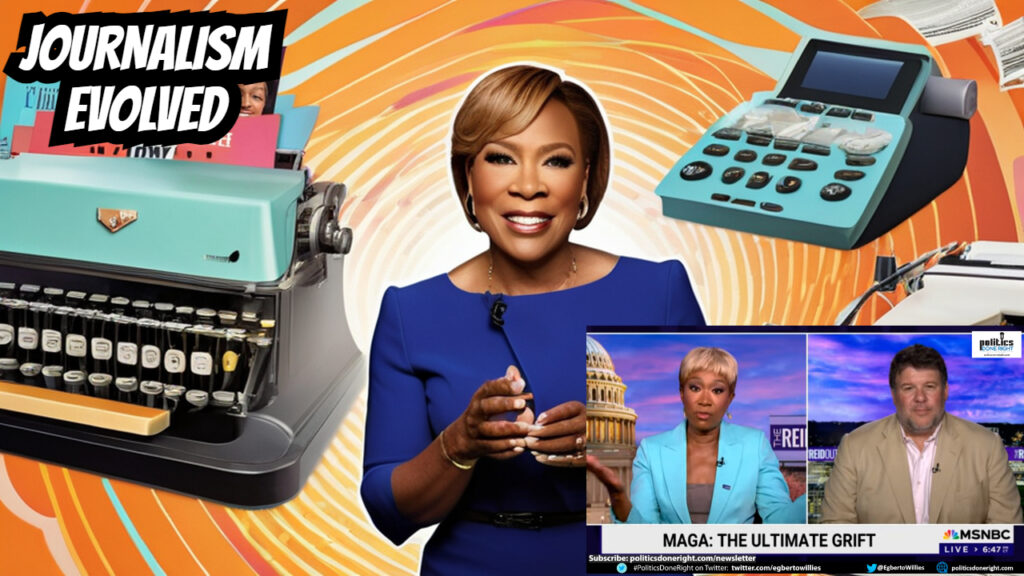In this interview with old-style journalist Jonathan Allen, Joy-Ann Reid uses new-style journalism to ensure that we are not left with Trump’s lies.
Joy-Ann Reid jettisons old-style journalism.
Podcasts (Video — Audio)
In journalism’s dynamic and ever-evolving landscape, Joy-Ann Reid emerges as a pioneering figure who challenges the traditional reporting norms. Her approach to journalism, as depicted in a compelling interview, marks a significant departure from old-style journalism that Donald Trump and his affiliates have adeptly manipulated to their advantage. Reid’s method, which some may view as controversial, proves effective and necessary in countering the narratives spun by figures like Trump, who have managed to navigate the conventional journalism model unscathed.
The essence of Reid’s journalistic philosophy lies in her refusal to adhere to the “he said, she said” format that has long governed the field. While aiming for objectivity, this traditional approach often fails to hold powerful figures accountable, allowing misleading narratives to proliferate unchecked. Reid’s style, by contrast, is assertive and analytical, delving deeper into the statements made by political figures to uncover the truth beneath the surface. In an era where misinformation can spread rapidly, her approach sheds light on the importance of rigorous scrutiny and the role of journalists as gatekeepers of truth.
Reid’s interview with reporter Jonathan Allen serves as a case study of the effectiveness of her technique. Allen, representing the old-style journalism, presents Trump’s actions and statements in a neutral manner, highlighting the launch of a donor access program involving personalized gold sneakers for those who raise substantial funds for Trump’s legal defense. Reid, however, does not let these statements stand unchallenged. She probes deeper, questioning the implications of Trump’s fundraising strategies and the disconnect between his populist image and the benefits accrued to his wealthy donors.
This interaction underscores a fundamental shift in the journalistic landscape, where merely reporting events and statements is no longer sufficient. In confronting Trump and his ilk’s narratives, Reid exemplifies the necessity of a more engaged and analytical form of journalism. She illustrates that to counter misinformation and biased narratives effectively, journalists must be willing to challenge the statements of political figures, unraveling the implications of their actions and policies.
Reid’s technique is not just about debunking falsehoods but also about exposing the underlying motives and consequences of political strategies that figures like Trump employ. Her focus on analysis over neutrality highlights the role of journalists in reporting news and educating the public about the broader implications of political actions. In doing so, Reid navigates the fine line between objectivity and advocacy, advocating for a form of informative and transformative journalism.
The interview with Joy-Ann Reid signals a shift towards a more assertive, analytical, and accountable practice. In an age where misinformation and biased narratives pose significant challenges to democracy, Reid’s approach offers a blueprint for how journalism can adapt and thrive. By prioritizing depth, analysis, and accountability, Reid challenges the status quo and reinforces journalism’s essential role in safeguarding the truth and promoting informed public discourse.
Reid’s journalistic practice, as highlighted in her interview, marks a critical departure from traditional approaches to reporting. Her method, characterized by a deeper analysis of political narratives and a commitment to uncovering the truth, stands as a template for the future of journalism. In a world where misinformation is rampant and political figures often manipulate narratives to their advantage, Reid’s approach underscores the imperative for journalism to evolve. It calls for a new era of reporting that is informative but also analytical and assertive, ensuring that the truth prevails in the public discourse.
Viewers are encouraged to subscribe and join the conversation for more insightful commentary and to support progressive messages. Together, we can populate the internet with progressive messages that represent the true aspirations of most Americans.

